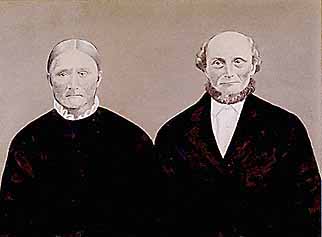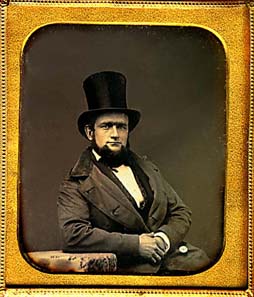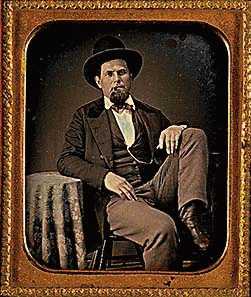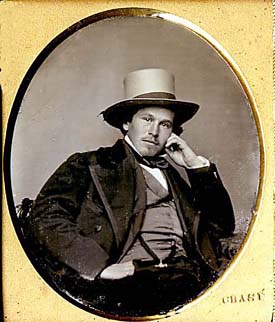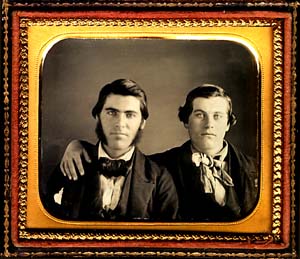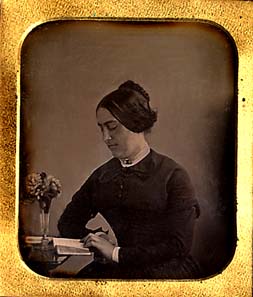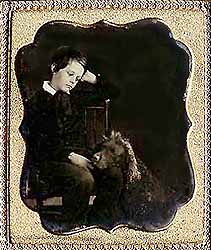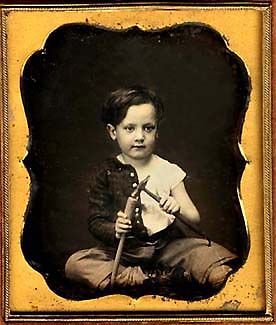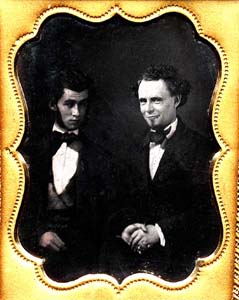Daguerreotype Portraits: At Ease [The American Museum of Photography]
AT EASE
The Informal Pose in American Portrait Daguerreotypes
There’s a widespread belief that all old photographs are stiff… painfully formal… somber affairs like the double portrait shown here. But this image (by C. A. McMillan & Co., Cincinnati) was made in 1883–a generation after the first portrait photographs were taken by the daguerreotype process.
The daguerreotypes in this exhibition, taken around 1850, are the antithesis of the “stiff old photographs” cliché. Because the sitters were required to hold still for a few seconds, these portraits are all posed. But the poses are informal, unselfconscious, and remarkably natural. They express moods ranging from conviviality to quiet reflection– going beyond the mere recording of a likeness and into the realm of capturing personality.
Click on any image below to view an enlarged version in a NEW browser window
Unless otherwise indicated, daguerreotypes are 2-3/4 x 3-1/4 inches by unknown American makers
The Daguerreian Journal, edited by S. D. Humphrey of New York, was the world’s first photography magazine. The following excerpts are from the issue of August, 1851:
“The Daguerreian Artist should possess quick perceptive powers; an eye for the beautiful, which will enable him at a glance to decide on expression and position. He will promptly, yet judiciously, select the view of the face most favorable for the just disposition of light and shadows–having placed the seat and chosen the most graceful and becoming position for the body, draperies, &c…
“The picture should express feeling, thought and intelligence. An embarassed, affected or constrained expression will always insure dissatisfaction and should be avoided, since it is the “every day,” “home” expression, which renders the picture an object of admiration in the familiar circle where it is to be, if at all, appreciated…
“Avoid stiffness–allow the drapery to fall loosely and gracefully–a gentleman’s cravat and collar should be so adjusted as to give the head perfect freedom –a little inclination of the person to the right or left, (towards the table, if one is introduced,) and an easy and spirited posture of the head should be deemed of the greatest importance. ..
daguerreotype by Lorenzo Chase, Boston
“If managed with a little tact on the artist’s part, the expressive life-like character of his picture, and the gratification of the original, will richly compensate him for his effort to please…
“Many faces, especially those who have well-proportioned and regular features, look well in ‘profile,’ but the outline of the face should be turned from the light, or placed in shadow. The arrangement of the ‘lights and shadows,’ as a general thing with Daguerreians has received but little attention;–all would profit by studying the works or productions of the most eminent artists…
“Many little and apparently trifling details help to make up the perfect picture. All should be thought of, and attended to, in a moment’s time–and as has already been observed, apparently without study or reflection, for time is precious, especially if the plates are ready coated and standing…
“[The daguerreotypist] must aim to be cheerful and pleasant under all circumstances, and especially patient and playful with children…”
“To succeed, please, and secure the admiration of his patrons, he must adapt himself at once, pleasantly, to the various characters and dispositions of those whom he is about to wait on.”
(ninth-plate daguerreotype, 2″ x 2-1/2″)

American Museum of Photography and the logo are Service Marks of The American Photography Museum, Inc.
